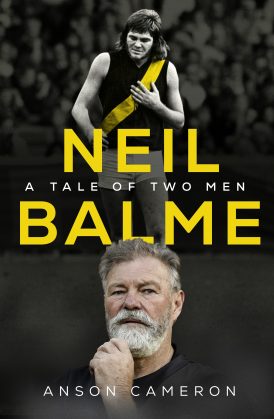Neil Balme
Archie Mac |Published: 2022
Pages: 324
Author: Cameron, Anson
Publisher: Penguin Random House
Rating: 4 stars

This is a surprising in-depth look at a football (Australian Rules Football) icon. Where some sporting biographies simply provide highlights of their subject, supported by a few stats, author Anson Cameron delves into the complicated personality of his subject. What we discover is a complicated, intelligent, caring and thoughtful man. This is far removed from what most would know of Neil Balme.
I first became familiar with Balme when he was coach of the Melbourne Football Club in the mid ‘90s. Every time he appeared on the tele, my father would say, ‘he was a thug when he played’. I think my father enjoyed the fact that Balme had a less than successful stint as an AFL (Australian Football League) coach.
The ‘thug’ statement was due to Balme’s reputation as an enforcer on the footy field. There is no doubt that some of his violence in the early 1970s, if it occurred in 2022, would have seen him rubbed out for months not weeks.
Some of the most interesting personalities in the game played in the same era as Balme, and Cameron does justice to the footy and the stars of that time. Cameron does such a quality job, that these chapters were my favourite in the book. Unfortunately, Balme retired early due to bad knees in his late 20s and so the coverage of his playing days accounts for less than a third of the book.
After his playing days Balme moved to South Australia to coach. It seems the hardman on the playing field was a very different person in the coaches box. He backed his players and had great success. His success as a coach didn’t translate to the AFL as a 42% winning rate during his five years at Melbourne suggests.
The real footy legend of Neil Balme came after his coaching days were done. He joins clubs in a variety of roles, being mainly designated as Football Operations Manager. Exactly what he brings to this role is regularly debated in the book. Cameron refers to the almost mystic properties of Balme’s influence over players, coaches and all the other staff at each football club he joins. Whatever his skills, the success at each club has been significant.
Cameron takes us into each club that Balme has been a part of. He dissects the culture and interviews all the main contributors. What Cameron gives us is some of the best writing on football club cultures you will read. From, the proposed Melbourne merger, to the rise of the success starved Cats, and finally the re-emergence of the sleeping giant, the Richmond football club. The other club, Collingwood, who Balme was with twice and which didn’t quite have the ultimate success is perhaps for that reason, the most engaging dissertation. The chapters on the Pies, were fascinating, with Eddie Mcguire’s ego seemingly being even larger than most would have imagined.
In the end, and despite my father’s misgivings, I have learnt that Neil Balme is truly a legend of footy. His knack of ending up at the right football club is clearly no fluke, and has continued with his choice of author to write his biography. Anson Cameron has done justice to his subject and his efforts should be read by all Aussie Rules fans.







Leave a comment